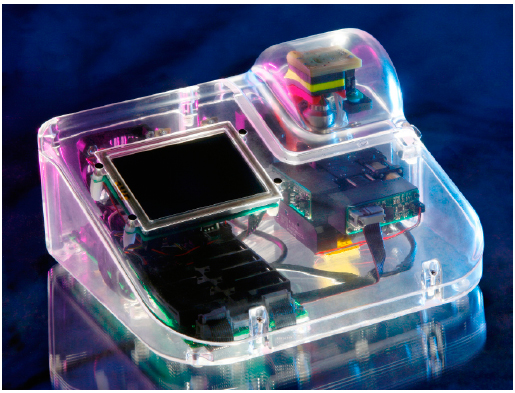Rapid Automated Point-of-Care System (RapiDx)
The Rapid, Automated Point-of-Care System (RapiDx) developed by Sandia National Laboratories is a portable diagnostic instrument. RapiDx quickly measures–with high sensitivity–disease and toxin biomarkers in human biological samples (e.g., blood, saliva, urine) so that patient ailments can be quickly diagnosed and treated. RapiDx is an ideal instrument for point-of-care diagnostics of disease and toxin detection in health clinics and in the field.

Built on Sandia’s advancements in lab-on-a-chip technologies, RapiDx is a miniaturized device that requires mere microliters of a sample to measure protein signatures. With RapiDx,drawing tubes of blood is no longer required. Instead, drops of blood or saliva can be collected and analyzed at the point of care (e.g., in a doctor’s or dentist’s office), there by enabling low-cost, rapid diagnoses during an office visit. RapiDx can also be used to address bioterrorism threats. If a crowd is exposed to dangerous biotoxins, potentially exposed persons can be triaged rapidly with RapiDx. Timely treatment–critical in such an event–also conserves valuable health resources (e.g., hospital beds, prophylactic supplies).
- Microfluidic: Only microliter volumes (e.g., a small droplet of saliva or blood) are required for analysis
- Easy sample collection: Designed for use with saliva or a pinprick of blood
- Multiplex: A panel of up to 64 analytes can be analyzed simultaneously for accurate assessment
- Rapid: A full panel of analytes can be measured within 10 minutes. Results can be obtained during a routine clinical visit
- Sensitive: Low-abundance markers and trace amounts of deadly toxins can be detected by sample peconcentration
- Wide, dynamic range: RapiDx is adjustable over several orders of magnitude by timing each preconcentration step
- Portable and easy to use: RapiDx offers automated, point-of-care testing with a simple touch-screen interface
- Low cost: RapiDx makes widespread screening, diagnosis, and monitoring feasible
- Versatile: A variety of diseases, infections, and intoxications can be diagnosed by switching antibody probes
- Disease detection: RapiDx microfluidic platforms may beused to analyze clinical samples to detect a collegenase enzyme associated with periodontal disease. Unlike the traditional approach–which uses invasive techniques– RapiDx has the potential to diagnose patients with periodontal disease at the first signs of microscopic bone loss, thereby enabling treatment before significant damage occurs. The highly versatile RapiDx can also be used to detect biomarkers that may be presymptomatic indicators of disease, such as cancer or cardiovascular disease.
- Ultrasensitive research tools: The microsystems developed for RapiDx are a step towards fulfilling fundamental needs for highly specific, ultrasensitive,high-throughput, and low-cost analytical tools that will not only improve our understanding of host response to infection and illness, but also aid researcher sengaged in drug discovery, biomarker verification, and new strategies for therapy.
- National defense: Troop readiness and field medical diagnosis and treatment are top priorities in national defense. RapiDx allows rapid, simple, and comprehensive diagnostics at low cost at a clinic or in the field. The device also enables quick and effective triaging in the event of intentional crowd exposure to biotoxins, thus improving the outcome for victims and enabling better use of healthcare resources. RapiDx provides direct detection of toxins as well as detection of the signature proteins that are elicited in response to toxin exposure.
- Hatch. (2010, October). “Aptamers as Affinity Reagents in an Integrated Electrophoretic Lab-on-a-Chip Platform.” Analytical Chemistry. 82(21), pp 8813-8820. [online]. Available: http://pubs.acs.org/doi/pdf/10.1021/ac101106m
- R. J. Meagher, A. V. Hatch, R. F. Renzi, A.K. Singh. (2008). “An integrated microfluidic platform for sensitive and rapid detection of biological toxins.” Lab Chip, 8:2046-2053. Available: http://pubs.rsc.org/en/content/articlepdf/2008/lc/b815152k
- A. V. Hatch, A. E. Herr, D. J. Throckmorton, J. S. Brennan, A. K. Singh. (2006). “Integrated preconcentration SDS-PAGE of proteins in microchips using photopatterned cross-linked polyacrylamide gels.” Analytical Chemistry. 78:4976-4984. Available: http://pubs.acs.org/doi/pdfplus/10.1021/ac0600454
- Y-C Wang, A.K. Singh, A.V. Hatch. (2008). “Ultra-rapid sample preconcentration under slant field using high-aspect-ratio nanoporous membranes.” Proceedings of MicroTAS 2008, The Twelfth International Conference on Miniaturized Systems for Chemistry and Life Sciences, San Diego, CA. October 12-16. Available: http://www.rsc.org/binaries/LOC/2008/PDFs/Papers/443_0808.pdf
- A. E. Herr, A. V. Hatch, D. J. Throckmorton, H. M. Tran, J. S. Brennan, W. V. Giannobile, A.K. Singh. (2007). “Microfluidic immunoassays as rapid saliva-based clinical diagnostics.” Proceedings of the National Academy of Sciences of the United States of America 104:5268-5273. Available: http://www.pnas.org/content/104/13/5268.full
SD# 11152 ;SD # 8604.1; SD# 8427.2; SD# 8412.1; SD# 8419; SD# 8427.1; SD# 8427; SD# 8471; SD# 8508; SD# 11178; SD# 11177; SD# 11282; SD# 10745.1; SD# 11149; SD # 10545.1
Published9/29/2011
Last Updated1/7/2025